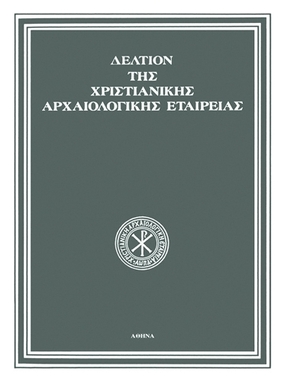Εικόνα των αγίων Ιουλίττας και Κηρύκου στο Βυζαντινό Μουσείο : Εικονογραφικές παρατηρήσεις
Part of : Δελτίον της Χριστιανικής Αρχαιολογικής Εταιρείας ; Vol.40, 2001, pages 181-190
Issue:
Pages:
181-190
Parallel Title:
An Icon of Sts Ioulitta and Kerykos in the Byzantine Museum : Iconographical Observations
Section Title:
Articles
Abstract:
Icon Τ 1740 (0.59x0.38 m) in the Byzantine Museum,Athens, is divided into two zones: depicted in the upper,larger zone is St Ioulitta, in half-body, holding her sonKerykos, and narrated in the lower zone, in two panels, arethe martyrdoms of the two saints.St Ioulitta, in strictly frontal pose, clad in a red dress, darkblue maphorion and white kerchief, holds a cross. St Kerykos, in three-quarter pose, his head turned behind and right,and his hands crossed on his chest, wears a short redgarment, a gold cuirass and bandages wound round thecalves. Both figures are identified by mis-spelt inscriptions:η Α[ΠΑ] ΥΟΥΛΗ/ΤΑ and Ο A[riOC] KIPYK[OC].In the lower zone, left, is the martyrdom of St Kerykos withthe prince on a marble throne kicking the child with his rightfoot. In the adjacent panel, right, in front of a building withiron-railings, a soldier prepares to behead St Ioulitta.The cult of the two saints flourished throughout the Byzantine Age in the Aegean Islands, Cyprus, Georgia and Cappadocia. In the Late Palaeologan period their venerationspread to North Greece and Serbia. Study of the iconographie rendering of the group of two saints in the upperzone of icon Τ 1740 revealed that the painter made innovations in several points, such as the pose, the garmentsand the facial features. On the contrary, research on therepresentation of their martyrdom is hindered by the fact ofits only sporadic appearance in Byzantine and Postbyzantinepainting.The Byzantine Museum icon of Sts Ioulitta and Kerykos,which can be dated to the sixteenth century on the basis of itsstylistic traits, is of particular iconographie interest, since itis the unique example of an icon in which the group of thetwo saints is combined with scenes of their martyrdom.
Subject:
Subject (LC):




